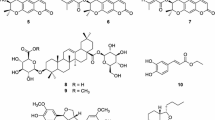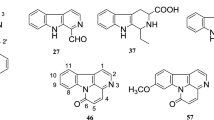Abstract
The overproduction of nitric oxide (NO) by inducible nitric oxide synthase (iNOS) is known to be responsible for vasodilation and hypotension observed in septic shock and inflammation. Inhibitors of iNOS, thus, may be useful candidates for the treatment of inflammatory diseases accompanied by overproduction of NO. In the course of screening oriental anti-inflammatory herbs for the inhibitory activity of NO synthesis, a crude methanolic extract ofCurcuma zedoaria exhibited significant activity. The activity-guided fractionation and repetitive chromatographic procedures with the EtOAc soluble fraction allowed us to isolate three active compounds. They were identified as 1,7-bis (4-hydroxyphenyl)-1,4,6-heptatrien-3-one (1), procurcumenol (2) and epiprocurcumenol (3) by spectral data analyses. Their concentrations for the 50% inhibition of NO production (IC50) in lipopolysaccharide (LPS)-activated macrophages were 8, 75, 77 μM, respectively. Compound1 showed the most potent inhibitory activity for NO production in LPS-activated macrophages, while the epimeric isomers, compound2 and3 snowed weak and similar potency. Inhibition of NO synthesis by compound1 was very weak when activated macrophages were treated with1 after iNOS induction. In the immunoblot analysis, compound1 suppressed the expression of iNOS in a dose-dependent manner. In summary, 1,7-bis (4-hydroxyphenyl)-1,4,6-heptatrien-3-one fromCurcuma zedoaria inhibited NO production in LPS-activated macrophages through suppression of iNOS expression. These results imply that the traditional use ofC. zedoaria rhizome as anti-inflammatory drug may be explained at least in part, by inhibition of NO production.
Similar content being viewed by others
References
Achike, F. I. and Kwan, C. Y., Nitric oxide, human diseases and the herbal products that affect the nitric oxide signaling pathway.Clin. Exp. Pharmacol. Physiol., 30, 605–615 (2003).
Bredt, D. S. and Snyder, S. H., Isolation of nitric oxide synthetase, a calmodulin-requiring enzyme.Proc. Natl. Acad. Sci. U.S.A., 87, 682–685 (1990).
Chi, Y. S., Cheon, B. S., and Kim, H. P., Effect of wogonin, a plant flavone from Scutellaria radix, on the suppression of cyclooxygenase-2 and the induction of inducible nitric oxide synthase in lipopolysaccharide-treated RAW 264.7 cells.Biochem. Pharmacol., 61, 1195–1203 (2001).
Green, L. C., Wagner, D. A., Glogowski, J., Skipper, P. L., Wishnok, J. S., and Tannenbaum, S. R., Analysis of nitrate, nitrite, and [15N] nitrate in biological fluids.Anal. Biochem., 126, 131–138 (1982).
Hong, C. H., Noh, M. S., Lee, W. Y., and Lee, S. K., Inhibitory effects of natural sesquiterpenoids isolated from the rhizomes ofCurcuma zedoaria on prostaglandin E2 and nitric oxide production.Planta Med., 68, 545–547 (2002).
Kim, E. J., Jin, H. K., Kim, Y. K., Lee, H. Y., Lee, S. Y., Lee, K. R., Zee, O. P., Han, J. W., and Lee, H. W., Suppression by a sesquiterpene lactone fromCarpesium divaricatum of inducible nitric oxide synthase by inhibiting nuclear factor-kappaB activation.Biochem. Pharmacol., 61, 903–910 (2001).
Kuroyanagi, M., Ueno, A., Koyama, K., and Natori, S., Structures of sesquiterpene ofCurcuma aromatica SALISB. II. Studies on minor sesquiterpenes.Chem. Pham. Bull., 38, 55–58 (1990).
Lowenstein, C. J., Glatt, C. S., Bredt, D. S., and Snyder, S. H., Cloned and expressed macrophage nitric oxide synthase contrasts with the brain enzyme.Proc. Natl. Acad. Sci. U.S.A., 89, 6711–6715 (1992).
Matsuda, H., Morikawa, T., Toguchida, I., Ninomiya, K., and Yoshikawa, M., Medicinal foodstuffs. XXVIII. Inhibitors of nitric oxide production and new sesquiterpenes, zedoarofuran, 4-epicurcumenol, neocurcumenol, gajutsulactones A and B, and zedoarolides A and B, from Zedoariae Rhizoma.Chem. & Pharm. Bull., 49, 1558–1566 (2001a).
Matsuda, H., Morikawa, T., Toguchida, I., Ninomiya, K., and Yoshikawa, M., Inhibitors of nitric oxide production and new sesquiterpenes, 4-epi-curcumenol, neocurcumenol, gajutsulactones A and B, and zedoarolides A and B from Zedoariae Rhizoma.Heterocycles, 55, 841–846 (2001b).
Mosmann, T., Rapid colorimetric assay for cellular growth and survival: application to proliferation and cytotoxicity assays.J. Immunol. Methods, 65, 55–63 (1983).
Nakayama, R., Tamura, Y., Yamanaka, H., Kikuzaki, H., and Nakatani, N., Two curcuminoid pigments fromCurcuma domestica.Phytochem., 33, 501–502 (1993).
Oshima, H. and Bartsch, H., Chronic infectious and inflammation process as cancer risk factors: possible role of nitric oxide in carcinogenesis.Mutat. Res., 305, 253–264 (1994).
Ryu, J.-H., Son, H. J., Lee, S. H., and Sohn, D. H., Two neolignans fromPerilla frutescens and their inhibition of nitric oxide synthase and tumor necrosis factor-a expression in murine macrophage cell line RAW 264.7.Bioorg. Med. Chem. Lett., 12, 649–651 (2002).
Ryu, J.-H., Ahn, H., Kim, J. Y., and Kim, Y.-K., Inhibitory activity of plant extracts on nitric oxide synthesis in LPS-activated macrophages.Phytother. Res., 17, 485–489 (2003).
Syu, W-J, Shen, C-C, Don, M-J, Ou, J-C, Lee, G-H, and Sun, C-M., Cytotoxicity of curcuminoids and some novel compounds fromCurcuma zedoaria.J. Nat. Prod., 61, 1531–1534 (1988).
Thiemermann, C. and Vane, J., Inhibition of nitric oxide synthesis reduces the hypotension induced by bacterial lipopolysaccharides in the ratin vivo.Eur. J. Pharmacol., 182, 591–595 (1990).
Thomsen, L. L., Ching, L. M., and Baguley, B. C., Evidence for the production of nitric oxide by activated macrophages treated with the antitumor agents flavone-8-acetic acid and xanthenone-4-acetic acid.Cancer Res., 50, 6966–6970 (1990).
Yoshihara, M., Yang, C., Zheng, C., Shibuya, H., Hamamoto, Y., Tanaka, N., and Kitagawa, I., Chemical conversion of (4S, 5S)-(+)-germacrone 4,5-epoxide, a plausible biogenetic intermediate found in the essential oil of zedoariae rhizoma from Yakushima, Japan.Chem. Pharm. Bull., 34, 434–437 (1986).
Yoshioka, T., Fujii, E., Endo, M., Wada, K., Tokunaga, Y., Shiba, N., Hohsho, H., Shibuya, H., and Muraki, T., Antiinflammatory potency of dehydrocurdione, a zedoary-derived sesquiterpene.Inflam. Res., 47, 476–481 (1998).
Author information
Authors and Affiliations
Corresponding author
Rights and permissions
About this article
Cite this article
Jang, M.K., Lee, H.J., Kim, J.S. et al. A curcuminoid and two sesquiterpenoids fromCurcuma zedoaria as Inhibitors of nitric oxide synthesis in activated macrophages. Arch Pharm Res 27, 1220–1225 (2004). https://doi.org/10.1007/BF02975885
Received:
Issue Date:
DOI: https://doi.org/10.1007/BF02975885




